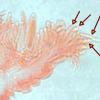
20-12-2025 23:08
Patrice TANCHAUDBonsoir, récolte sur sol sablonneux dans l'arri�

21-12-2025 09:32
Hello.A tiny ascomycete found embedded in wood in

20-12-2025 15:47
Mirek GrycHi.These grew on pine wood that was heavily covere

18-12-2025 21:17
Pol DebaenstThe identification took me to Byssonectria deformi

15-12-2025 07:09
 Danny Newman
Danny Newman
indet. Rutstroemiaceae sp. on unk. fallen leavesMc

19-12-2025 10:10
Patrice TANCHAUDBonjour, récolte réalisée en milieu dunaire, a

18-12-2025 17:23
 Bruno Coué
Bruno Coué
Bonjour,je serais heureux d'avoir votre avis sur c
There are some similarities to Hyaloscypha minuta, but the spore size (in particular) seems to be aberrant. I have more material, but the size makes it quite difficult to manipulate the ascomata and it would help to know which features to focus on.
The hairs look quite short or scarce (not noticeable under stereoscope) and plain, but the paraphyses seem Hyaloscypha-like (filiform without VBs). I couldn't match the features well with any species in Huhtinen's monograph on Hyaloscyphus (croziers, hemiamyloid rings, spore size), and I also considered Hyphodiscus (Hyphodiscaceae), but the disc isn't smooth, and the hairs don't seem right.
Habitat: Observed in January, on decaying (unidentified) deciduous wood, decorticated and often blackened parts, small pile of logs, presumably hygric, shady area, mixed deciduous woodland, southern England.
Associates: Several types of conidia found around base, many ascomata arising from or close to dematiaceous spore mat, on the same pile of logs - Calycina cf. citrina (previously), Lachnum impudicum, Orbilia eucalypti (previously), Trichoderma strictipile (aged ascomata), Mollisia sp., Peniophora sp.
Preparation: Stored for a day in a damp container attached to wood, slides prepared from two ascomata, sections attempted but only some success with second ascomata, progressively squashed, mounted in tap water or KOH with IKI or CR applied afterwards.
Ascomata: Hyaloscypha minuta-like, gregarious to clustered, superficial, < 0.5 mm diameter (maybe even smaller max), whitish-ochraceous, possibly more yellow with age, translucent, pruinose, some with lumps of orange exudate, initially cupulate to turbinate, then discoid to scutellate-pulvinate, often appearing sessile and appressed in maturity, no clear differentiation between receptacle and disc, occasionally uneven margin in maturity.
Reactions:
- IKI (~1%): Apical rings rr - rb (hemiamyloid), possibly bluer at the top, Calycina-type, any other reactions standard.
- KOH: Exudate dissolving, some +/- amyloid (violaceous) crystals remaining, no other reactions.
Paraphyses: Few, not exceeding asci, no VBs, filiform to lanceolate-clavate (inflated near apex), thin-walled, width ~1 - 2 µm, some dichotomously branching near base, septate, apical cell seems longer.
Asci: Inoperculate, 8-spored, croziers +, cylindrical to clavate, thick-walled, apex rounded to acute, one spore at apex, some spores horizontally oriented, spores often obliquely arranged, 1 – 2 (3) seriate.
Vital (presumed): Turgid, more clavate, apex more rounded, apical dome less pronounced (harder to see rings), pars sporifera ~50%.
Measured in tap water or IKI:
(30.6) 31.4 - 33.7 (34.2) × (6.3) 6.7 - 8 (8.4) µm,
Q = 4 - 4.5 (5.1), N = 7,
Me = 32.4 × 7.2 µm, Qe = 4.4.
Dead (presumed): Generally flaccid, often more narrowly-cylindrical, sometimes spores grouped towards base causing more lageniform shape, apex more acute and truncate, apical dome pronounced, some spores may be reversely oriented, pars sporifera ~80-90%.
Measured in KOH:
(28.2) 28.5 - 34.8 (36.1) × (4.1) 5.1 - 7.5 (8.3) µm,
Q = (4) 4.3 - 6.2 (7), N = 23,
Me = 31.8 × 6.1 µm, Qe = 5.3
Spores: Ellipsoid-ovoid, often inequilateral in profile view, occasionally heteropolar?, usually multi-guttulate, 1 (- 2) medium-size and several smaller LBs towards each pole, OCI 1 - 3, no septa identified.
Vital spores in tap water squash mount, some measured in asci (agreeable with a few spores ejected from sections):
(4.7) 5.1 - 6 (6.3) × (2.4) 2.5 - 3.1 (3.5) µm,
Q = (1.6) 1.7 - 2.2 (2.4, N = 30,
Me = 5.6 × 2.8 µm, Qe = 2
Subhymenium: Hyaline hyphae.
Marginal hairs: Hyaline, short, cylindrical (to lageniform?), crystallised, no ornamentation?, apex rounded, appear 2 – 3 septate.
Ectal excipulum: Hyaline, textura prismatica, possibly more textura angularis towards base.
Marginal cells: Elongated, one cell protruding, larger and more pyriform around the base, yellowish at base.
Exudate: Ochraceous-orange with crystals, noticeably orangish in concentration around margin, hyaline fragments in water mount, large hyaline crystals found in water mount may not be associated.
Medullary excipulum: Appears to be a small central column of hyaline hyphae that is textura intricata-porecta.
Anchoring hyphae: Some brownish hyphae around base.
Subiculum: None identified.
Anamorph: No direct associations identified.


Look in direction Hyphodiscus, may be Hyphodiscus hyaloscyphoides.
You need better pictures from hairs.
https://drive.google.com/drive/u/0/folders/0B5SeyOEkxxZhazllLU1IemNVZlU?tid=0B5SeyOEkxxZhYVZub0N1aGY5YTg&resourcekey=0-6c-dufxw6WPl5FQxwsmRhQ
Greetings
Ingo W

I am glad you said that species, because it is what I got from the Quijada et al. key (ascus length, spore size, hemiamyloid, macro, habitat). I then convinced myself that the disc wasnt smooth enough for the genus/family and I didnt see any warty apical cells from hairs.
Unfortunately my sections got stuck together and the photos are rather disappointing. I may have another try to get better photos if I can face trying to handling the ascomata again.

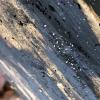
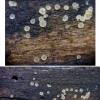
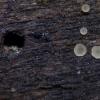
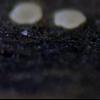


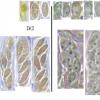
 Sections-0001.jpeg
Sections-0001.jpeg